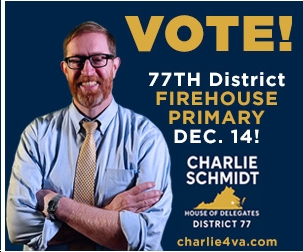In 2013, as you’re aware, Virginia Democrats swept all three statewide offices – Governor, Lt. Governor, Attorney General – albeit not by huge margins (a 2.5-point win for Terry McAuliffe over Ken Cuccinelli, a 165-VOTE win for Mark Herring over Mark Obenshain). In part due to those narrow wins for Governor and Attorney General, Democrats ended up falling short in a bunch of Obama/Clinton House of Delegates districts. For instance:
- Democrats lost the 12th House of Delegates district, won by Mark Warner in 2014 with 52% of the vote, and also won by Hillary Clinton (although barely) in 2016, by 891 votes.
- Democrats lost the 13th House of Delegates district, where Hillary Clinton won 54% of the vote this past November, by just 498 votes.
- Democrats lost the 31st House of Delegates district, where Hillary Clinton won 51%, by just 228 votes.
- Democrats lost the 32nd House of Delegates district, where Hillary Clinton won around 56%, by just 651 votes.
- Democrats lost the 34th House of Delegates district, where Hillary Clinton won 56%, by just 422 votes (note that this one gave us the deplorable Barbara Comstock – ugh!).
- Democrats lost the 67th House of Delegates district, where Hillary Clinton won 58%, by just over 2,100 votes.
- Democrats lost the 86th and 87th House of Delegates districts, both in the neighborhood of 60% Clinton districts (and both taken by Democrats in 2015), by a handful of votes (54 votes in the 86th, 187 votes in the 87th).
- Democrats lost the 94th House of Delegates district, which Hillary Clinton won with around 50% in 2016, by just 543 votes.
And that’s not even counting the “Clinton districts” (the 68th, 72nd, 73rd) where Democrats didn’t put up an opponent.
Again, that was all with Democrats winning the statewide offices by very small margins (except for Ralph Northam, who beat Ewwwww Jackson handily). In 2017, what happens if Ben “Not Larry Sabato” Tribbett’s observation about Virginia swinging hard against the party in the White House during a president’s first term (and especially if Trump continues to be intensely unpopular in Virginia, as he has been so far)? Again, as Tribbett observed (relayed by John Fredericks), the “least swing that’s ever happened between a new president gets elected and then the governor’s election happens the next year in Virginia, the least swing the other way in history has been 13 [percentage points].”
So what happens, let’s say, if instead of winning the governor’s race in 2017 by 2.5 points, Democrats win it by 15 points? Or, to be less optimistic, let’s say Democrats win it by 5 points, as Clinton did in November 2016, or a few points higher than that (6-10 points, let’s say)? Let’s also assume that if Democrats DO win the statewide races by significantly wider margins than we did in 2013, that it will be because of significantly increased turnout by fired-up Virginia Democratic voters this year, possibly lower Virginia Republican “base” turnout? Also, keep in mind that this year, Democrats could have a lot MORE candidates for House of Delegates running, as well as a bunch of high-quality candidates aided by lots and lots of Democratic volunteers from Virginia and around the country. What could that mean for “dropoff” between the top of the ticket and the “downballot” races?
Let’s start by being moderately optimistic and assume that Democrats win Virginia in 2017 by 5 percentage points, instead of just 2.5 percentage points. What would happen in the “Clinton districts” listed above under this not-particularly-optimistic scenario? (note: I’m focusing on the 2013 AG race as a baseline because that one is “cleaner” than the Governor’s race, which had a third-party, libertarian candidate in the mix; also note that these are VERY rough estimates, meant to be illustrative, not precise by any means).
- In the 12th, Mark Herring got 8,810 votes, while the Democratic HoD candidate (James Harder) received 8,650 votes, a “downballot dropoff” of 160 votes. The winning Republican candidate, Joseph Yost, received 9,541 votes. Add in 2.5 more percentage points for the top of the ticket, and we’re talking around 450 more votes — still not quite enough to win the district, but getting there (e.g., if Democrats win statewide by 10 points, then this could translate into nearly 900 more votes in the 12th, enough for the Democratic HoD candidate to eke it out).
- In the 13th, Mark Herring received 8,256 votes in 2013, while the Democratic HoD candidate (Atif Qarni) got 8,448 votes (yes, Qarni actually OUTPERFORMED the top of the ticket). Unfortunately, the winning Republican candidate, “Sideshow Bob” Marshall, received 8,946 votes. Again, assume Democrats win the state this time by 5 points instead of 2.5 points, and we’re talking more than 400 more votes, bringing the Democratic HoD candidate verrrry close to beating “Sideshow Bob.” Bring that up to 10 points, and the Democratic HoD candidate should win fairly easily. So…definitely watch out in the 13th HoD district this November!
- In the 31st HoD district, Mark Herring won 11,209 votes in 2013, while the Democratic HoD candidate (Jeremy McPike) received 11,280 votes (yep, McPike outperformed the top of the ticket as well, although not by as much as Qarni did in his race). Bring the statewide margin of Democratic victory up to 5 points in the governor’s race, and Democrats should add more than 500 votes in this HoD race, easily winning the district.
- In the 32nd HoD district, Mark Herring won 11,325 votes in 2013 to just 9,425 votes for Mark Obenshain. Unfortunately, Republican Del. Tag Greason wildly overperformed Obenshain here, winning 11,735 votes, while Democrat Elizabeth Miller won 11,084 votes, a 241-vote “dropoff” from Herring. Combine those, and you end up with a narrow Greason win here. But let’s say Democrats win the Virginia governor’s race by 5 points this year instead of 2.5 points? We’re likely talking 500+ more votes for the Democratic HoD candidate, which would make this one neck and neck. Get up to a 10-point top-of-the-ticket margin of victory, and the Democratic HoD candidate should win here easily.
I could go on with this all day, but by now I think you get the idea: that IF Democrats win Virginia this year at the statewide level – for Governor, Lt. Governor and Attorney General – by a few more points than we did in 2013, and IF this translates “down ballot,” and IF we have strong candidates in key districts, and IF the Democratic energy we’re seeing now continues, and…we could – emphasis on COULD – pick up a bunch of House of Delegates seats. Also, if we get close to Ben Tribbett’s historic scenario, then it really becomes a tsunami, but I’m not ready to get THAT excited yet. Add in the fact that Democrats could end up with strong challengers in a lot more Republican-held HoD districts this year than we did in 2013, and also that the Orange Fascist is in the White House, and this could (in theory; lots to do in order to translate that into reality) be quite a year for Virginia Democrats. But first, we’ve got a LOT of work to do. So stay (or get) involved, stay (or get) engaged, and hopefully we can look forward to something worth celebrating this November after this dark, horrible few months…
P.S. I ran this post by Ben Tribbett for his comments before posting. He gave me permission to quote him.
“Its interesting, not the angle I would take but worth discussing. The surge is proven for Governor only, so the better question is why do our House candidates trail by so much and what is being done to bring them closer to Governor number? Example: Jennifer Boysko loses by 40 votes in 2013. Terry won her district by 19 points I think. Murphy loses by 1% to Comstock while Terry wins there by 15 or so…your post is assuming the House candidates also get that surge…WHY have the candidates been so far behind top of ticket and WHAT are we doing to solve that?…Absentees are not broken out for statewides in districts…But they are for house candidates, so they are actually well ahead. That’s why I always equalized the absentees for NLS which is what VPAP does not do… Both sides get a small dropoff in participation downballot…It just looks like all ours because we are losing swing voters so badly that it makes for an illusion in the results…For example, say Northam wins a precinct 900-700 and the GOP Delegate wins 800-750; it looks like 50 of our people didnt vote and they won 100 crossover. What really is more likely is they won 125 crossover and both sides lost 25 downballot. So it creates an illusion…No House candidate has run ahead of top of ticket since 2001 – as a challenger on Dem side I should say.”
P.P.S. I also added – and Ben agreed – that our messaging from the governor’s office is completely opposite of what it should be to set up for a House of Delegates election year. Instead of doing what governors tend to do (and which Terry McAuliffe just did a few days ago), which is tout their great bipartisan cooperation in the General Assembly, blah blah blah, what a Democratic governor SHOULD be emphasizing is the truth — how extreme, crazy, etc. the right-wing General Assembly is, how it demonstrates the urgency of holding the Governor’s Mansion AND winning as many House of Delegates seats as possible. But instead, we get the bipartisan b.s. blather, which is both false AND unhelpful politically. Gack.



![Video: Former Eastern District of VA Federal Prosecutor Gene Rossi Asks, “Is Donald Trump going to be the lead counsel in that prosecution [of Jim Comey] and do the opening, closing and rebuttal? I pray that he does!”](https://bluevirginia.us/wp-content/uploads/2025/09/rossiedva-238x178.jpg)











